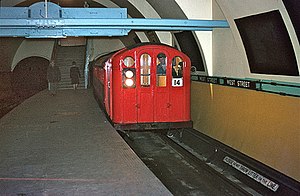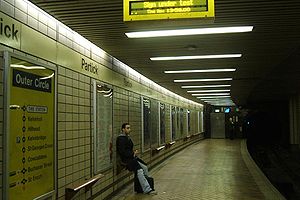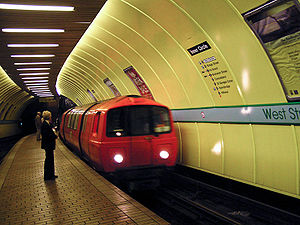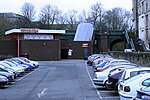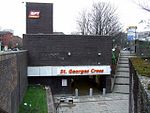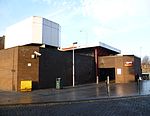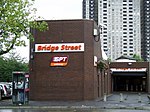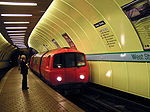Glasgow Subway
The Glasgow Subway is an underground railway line in Glasgow. Opened on 14 December 1896, it is the third-oldest underground metro system in the world after the London Underground and the Budapest Metro. It is the only heavy rail underground metro system in the British Isles outside London, and also the only one in the British Isles which operates completely underground. It is also one of the very few railways in the world with a track running gauge of 4ft. Formerly a cable railway, the Subway was later electrified, but its twin circular lines were never expanded. The line was originally known as the Glasgow District Subway, but was later renamed Glasgow Subway Railway. It was so called when taken over by the Glasgow Corporation who renamed it the Glasgow Underground in 1936. Despite this rebranding, many Glaswegians continued to refer to the network as "the Subway". In 2003 the name "Subway" was officially readopted.
Contents
Route
The route is a loop almost 6½ miles long and extends both north and south of the River Clyde (map). All but two of the stations are in Lanarkshire; the exceptions being Shields Road and West Street, which are in Renfrewshire. The tracks have the unusual narrow gauge of 4ft, and a nominal tunnel diameter of 11ft, even smaller than that of the deep-level lines of the London Underground 11ft 8¼in at their smallest); the rolling stock is considerably smaller.
The system describes itself as two lines, the Outer Circle and Inner Circle, but this simply refers to the double track, having trains running clockwise and counterclockwise respectively around the same route although in separate tunnels. Stations use a variety of platform layouts including single island platforms, opposing side platforms and in some stations such as Hillhead one side and one island platform.
The subway’s running lines are entirely underground, but the maintenance depot at Broomloan Road (located between the Govan and Ibrox stations) is above ground, as was the earlier depot, also at Govan. Prior to modernisation, trains used to be hoisted by crane onto and off the tracks. Modernisation brought the installation of points and a ramp between Govan and Ibrox where trains can exit the tunnel system to terminate for engineering, cleaning or storage.
The system carried 13.16 million passengers in the period 2005-06.[1] The Subway has been policed by British Transport Police since 2007.[2]
History
1896–1977
The Glasgow District Subway Company began construction of the underground in 1891 and opened on 14 December 1896, the subway was powered by a clutch-and-cable system, with one cable for each direction. The cable was driven from a steam-powered plant between West Street and Shields Road stations. There was no additional cable to allow trains to reach the depot; instead, they were transferred to and from the running lines by crane operating over a pit at the Govan workshops. This also meant that the two tracks could be completely separate, with no points anywhere. The company's headquarters were in the upper rooms at St Enoch subway station; this distinctive ornate building still stands in St Enoch Square and was subsequently used as a travel information office by SPT and is now a coffee shop.[3]
When the Subway first opened, single-carriage four axle (twin truck) trains were operated.[4] An accident on the opening day entailed the closure of the Subway until 19 January 1897.[5] The 20 original wooden bodied carriages were built by the Oldbury Railway Carriage and Wagon Company, of Oldbury, Worcestershire. Many continued in service until 1977 in an upgraded form. A further 10 were delivered by the same manufacturer in 1897. From 1898, second four axle (trailer) carriages without a cable gripper mechanism were added, though they were considerably shorter than the front (gripper) carriage. These additional carriages, eventually numbering 30, were built by Hurst Nelson & Company, Motherwell, Lanarkshire. These carriages were soon expanded to match the length of the front carriages, although carriage 41T has been restored to its original length and cut longitudinally and can be seen preserved at Buchanan Street subway station and number 39T is preserved in the Riverside Museum. Most of the gripper carriages were subsequently converted to electric traction in 1935. All carriages were originally built with lattice gates (instead of doors) at the ends; many were converted to air-operated sliding doors in the 1960s, but a few retained the gates until 1977.[6]
All 15 stations were built with island platforms. The trains were thus built with doors on one side only. Power for the electric lighting in the trains was supplied by two parallel wall-mounted rails (known as "T-irons") at window level on the non-platform side of the trains; trains were originally equipped with wheels to pick up the electricity but changed to skids at electrification.[7] The trains remained cable-hauled until 1935, though the anachronistic way of supplying power for the lighting continued until 1977. The lighting circuit was also part of the operation of the signalling system.[8]
Opening times of the Glasgow subway have varied through the years, now open late midweek every day and 10.00am-6.00pm on Sunday following a trial period between April 2011 - 2012 when the subway was open from 9.00am-6.30pm.
Glasgow Corporation took over the company in 1923. In 1935, the existing trains were converted to electric power delivered by a third rail at 600 volts, direct current.[9] From March until December 1935, clockwise trains were cable-hauled, whilst anti-clockwise ones were electric. The trains lost their original plum and cream-coloured liveries, being painted red and white instead. From the 1950s the trains became all red — in a shade similar to that of London buses. During the early 1970s, trailer carriage number 41 was repainted in the original 1896 livery.
After the Beeching Axe of the 1960s, both St Enoch and Buchanan Street mainline stations were closed and demolished, However, there was no direct connection between the underground and mainline stations of Buchanan Street as they were over 550 yards distant. The Subway had had no direct passenger connection to the national railway network — a major weakness — although Buchanan Street and Merkland Street stations were a short walk from Queen Street and Partickhill British Rail stations respectively.
Before the 1977–80 modernisation, the stations had a distinctive earthy odour. The trains (mostly dating back to 1896) were always formed with two carriages — the front (motor) carriage with red leather seats and the rear (trailer) carriage with brown leather seats.[9] Smoking was permitted in the rear carriage only. The backs of the seats were attached to the sides of the carriages, which moved semi-independently from the floor (to which the seats themselves were attached); passengers were rocked forwards and backwards while the carriage 'shoogled' them around. Passengers always entered at the middle of the train ("Q[ueue] Here" signs were painted on the platforms), leaving by the front door of the front carriage or the rear door of the rear carriage.
By the 1970s, the stations were very dilapidated. Stations were marked with circular signs often attached to lampposts. This sign had a white background in the top three quarters (containing a large red letter "U") and black in the bottom quarter (containing the word "UNDERGROUND" and an arrow to the station entrance). No station had an escalator; although Kelvinbridge did have a lift. Each station had a ticket office (often very small, little more than a booth with a window). The ticketing system was identical to that of most cinemas of the era, with tickets emerging from slots in the counters of the station ticket offices. Tickets were invariably collected on leaving the train. From the time of being taken over by the Corporation until 1977, the staff were issued with tramway uniforms; these were dark green and had a black braid on the cuffs which had been introduced at the time of the funeral of Queen Victoria in 1901.[10][11]
Glasgow's Museum of Transport has an area dedicated to the subway, with models showing the operation of the clutch-and-cable system, as well as a full-scale replica of part of a subway station, complete with different rolling stock of the pre-modernisation era.
Modernisation (1977–1980)
By the 1970s, use of the Subway had declined significantly. This was caused partly by the closure of some of the dockyards and by widescale demolition of tenements south of the River Clyde. The original carriages, mostly dating back to 1896, were still in use, though adapted for electric traction in 1935. Breakdowns were becoming increasingly frequent; because trains could only be removed from the tracks to the depot by crane, a single inoperable train could cause major delays. The future of the Subway became a major issue for the Greater Glasgow Passenger Transport Executive, which took over responsibility for the line from Glasgow Corporation in the late 1960s.
On 24 March 1977, cracks were noticed in the roof of Govan Cross station, leading to suspension of services until 2 May. The service resumed with only four trains per circle. On 21 May 1977, the system was shut down eight days prematurely for a major refurbishment and modernisation; the date was brought forward because of the appearance of more cracks in the roof of Govan Cross (now Govan) station. Badly deteriorated tunnels were repaired; stations were rebuilt and enlarged, with additional platforms at Buchanan Street, Partick, Govan, Ibrox, Hillhead and St Enoch. The entrance to Kelvinbridge was reversed, with a new entrance and car park built at South Woodside Road, an escalator to Great Western Road and stairs down to the west end of the platform; the former entrance and stairway at the east end became an emergency exit, and the lift was withdrawn from service. Merkland Street station was closed; a new station to the north was built at Partick to provide an interchange with the North Clyde suburban rail system. The site of the former Merkland Street subway station can be noticed by the characteristic hump and the larger-diameter tunnel with both tracks. Many fittings from Merkland Street were used to build a replica pre-modernisation station at the Glasgow Museum of Transport, containing three preserved cars.
Heavier track was installed although still at the unique 4ft gauge, the original Broomloan Depot was modernised and equipped with connecting tracks with points to replace the crane transfer, and a new electrical supply from Westinghouse Electric Corporation was installed. A new ticketing system, with passenger-operated ticket vending machines and automatic turnstile barriers, replaced the old, perforated cinema-style tickets and conductors. The post-1980 yellow tickets have since been replaced by a newer system, issuing magnetic stripe card tickets.
Since modernisation
The line was formally reopened by Queen Elizabeth II on 1 November 1979. However, rebuilding work was still incomplete, and the line did not reopen to passengers until 16 April 1980. Thirty-three new carriages were built by Metro Cammell at its Washwood Heath works in Birmingham, and equipped with GEC electric motors. The exterior design of the trains was carried out in partnership with Glasgow School of Art, which, according to SPT publicity films of the day, was largely responsible for the trains' "cute" appearance. Eight additional centre-trailer carriages were built in 1992 (the body shells by Hunslet Gyro Mining Transport Ltd in Leeds for completion by Hunslet-Barclay Ltd in Kilmarnock), making all trains three carriages long. Smoking has never been permitted on the modernised system.
A new corporate identity was introduced (following contemporary fashions of the 1970s), with trains painted bright orange, stations largely rebuilt with dark brown bricks, orange-yellow wall tiles and other surfaces in off-white, plus brown uniforms for the staff. Large, illuminated orange "U" signs were placed at station entrances (since removed, with the re-adoption of the name "Subway"). Since the 1990s, ongoing renovation work has resulted in most stations adopting individual colour schemes. The trains' initial orange livery of 1980 (with a white stripe) was soon replaced by a darker, more durable shade of orange, itself now being replaced by SPT's latest carmine-red and cream livery.
Stations
The stations of the Subway, in clockwise order from Partick.
References
- ↑ "SPT passenger facts". Archived from the original on 2008-05-11. http://web.archive.org/web/20080511194235/http://www.spt.co.uk/subway/facts.html#passengers.
- ↑ 'Police For Glasgow Subway', The Times, 3 January 2007
- ↑ "Subway - History". Archived from the original on 2006-08-20. http://web.archive.org/web/20060820232023/http://www.spt.co.uk/subway/history01.html.
- ↑ Casely, G. and Hamilton, Wm., I belong to Glasgow: The human history of the Glasgow Underground, Nexus Press Ltd, Glasgow (2nd edition, 1976), p. 28
- ↑ Irlam, Michael J.. "A Scottish District Subway". Mike's Railway History. http://mikes.railhistory.railfan.net/r048.html. Retrieved 2007-01-10.
- ↑ "Subway - History". Archived from the original on 2008-03-30. http://www.spt.co.uk/subway/history02.html.
- ↑ Casely and Hamilton, ibid, p. 43
- ↑ "Subway - History". Archived from the original on 2008-03-30. http://www.spt.co.uk/subway/history03.html.
- ↑ 9.0 9.1 Casely and Hamilton, ibid, p. 45
- ↑ "Subway - Chronology". Archived from the original on 2008-03-30. http://www.spt.co.uk/subway/history04.html.
- ↑ Glasgow Transport Memorobilia
Further reading
- J. Wright and I. Maclean, Circles under the Clyde: A history of the Glasgow Underground, Capital Transport, 1997, ISBN 1-85414-190-2
- Hunt, John (4–17 June 1997). Running like clockwork!. EMAP Apex Publications. OCLC 49953699.
Outside links
| ("Wikimedia Commons" has material about Glasgow Subway) |
- Photos of the Glasgow Subway Before/During Modernisation, ca. 1977-80
- Strathclyde Partnership for Transport — Subway
- Photographs of Glasgow’s rolling stock
- Article and photo gallery about the Merkland Street station (now Partick)
- A website displaying many different items from the Glasgow Subway
- Collection of Google Earth locations of SPT Subway stations (Requires Google Earth software) from the Google Earth Community forum.
- Glasgow Page at Urbanrail.net
- Details and pictures of the Subway renovation in the 1970s
- Architecture photo series of all stations of the Glasgow Subway as per 03/2014

